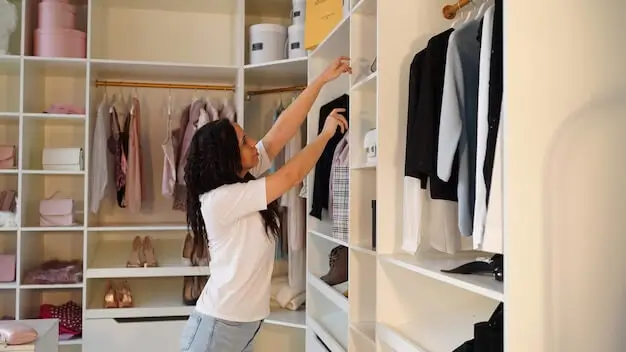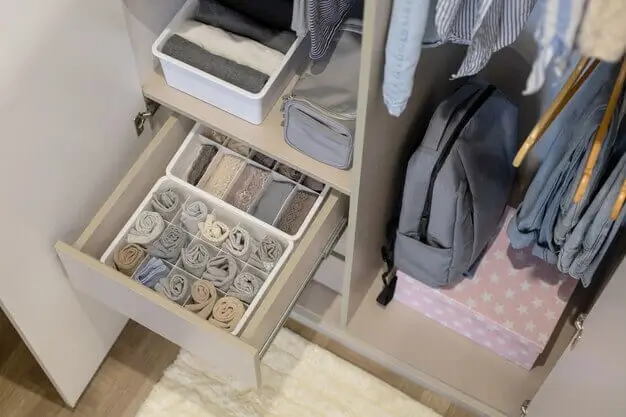Welcome to the realm of streamlined living, in which every object has a home and every morning begins without incident. It’s time for a change if you’re continually searching through stacks of clothes for your preferred sweater or stepping over shoes to access your work apparel. Your first step towards a more ordered life is this book, “Closet Organisation Essentials: 5 Steps to a Clutter-Free Space.” Closet organisation is about changing your everyday life by making your personal space more useful and pleasant, not only about neatness.
We will walk through a methodical, five-step procedure in this article meant to enable you recover your closet from the grip of mess. From organising and decluttering to using clever ideas to maximise your storage, these methods will help you create a closet that makes selecting an outfit enjoyable rather than a task. Get ready to transform the way you arrange your clothes and accessories whether your wardrobe could use some creative ideas to maximise space or your walk-in closet needs taming. Let’s start this path to design a closet that fits your way of living free from clutter.
First step: Organise and purge.

The first step in learning closet organisation is the intimidating but freeing clearing process. Start by totally emptying your closet—that is, yep, every single item. Arrange everything so you can plainly see every bit. This all-encompassing perspective lets you assess your clothes dispassionately.Ask yourself, as you sort through your stuff: “Have I worn this in the last year?” Should your response be no, you probably should start to distance yourself from that object. This kind of decision-making enables you to assemble accessories and clothing you really wear and value.Use the “one in, one out” approach to stop future clutter.
Choose an old item to give or toss for every new one you add to your closet. This helps you to keep your wardrobe under control and revitalises your collection without allowing it to run wild. Not only does methodically decluttering liberate important closet space, but it also helps you to reconnect with the items you love, therefore enhancing the dressing every day experience.
Second step: sketch your perfect closet layout.
Maximising the effectiveness of your closet space comes next once you’ve simplified your clothes. To better fit your remaining goods, this could call for adding more drawers, shelves, or specific hanging organisers. Retailers such as The Container Store and IKEA provide adaptable closet systems include the Elfa and Boaxel systems, which can be fitted to the particular measurements and needs of your room.
When you reorganise, think about how you daily use your clothing in terms of logistics. To streamline your morning ritual, arrange the most regularly used objects in handy places. Remember also the possibilities of vertical space. Installing over-the-door shelves or adding shelf dividers would greatly increase your storage choices and help you to keep more goods without clutter. These changes not only improve the functionality of your closet but also help it to remain long-term organised.
Third step: make investments in sensible storage options.
After your closet is carefully arranged, the next step is to make investments in premium organisers that exactly meet your particular demands. Maintaining order and making sure every item has a specific place depends on basics including drawer divisions, storage containers, and shoe racks. These instruments not only help to maintain your area neat but also simplify your daily schedule.Larger bins can be quite handy for bulkier goods like coats and sweaters.
Alternatively, think about employing space-saving vacuum bags to substantially cut the volume of these bulky objects and create priceless closet space free-from. Effective housekeeping is mostly dependent on good organisation; so, investing in these items will pay off in terms of appearance as well as utility.
Choosing simple storage options can sometimes make all the difference. Clear bins and divisions let you quickly view the contents, therefore saving a great deal of time searching for particular objects like belts or scarves. This visibility not only facilitates the grabbing of what you need but also helps to maintain the organisation since it lets you see right away when things are out of order.
Fourth: Keep a methodical approach.
Keeping your closet in order requires constant work rather than a one-time cleanup exercise. Think about labelling shelves and bins to assist the company last. This will help you to remember where each item belongs and simplify your procedure of storage. This arrangement maintains your closet looking tidy and helps to reduce the time spent seeking for goods.
Developing the practice of straight after usage returning objects to their intended locations is absolutely vital. This exercise will progressively fit into your daily schedule and nearly become second nature, even if it may call some early discipline. Preventing clutter from returning into your closet depends on such regularity.
Particularly helpful for handling clothing and accessories, professional organisers sometimes recommend the FIFO (First In, First Out) approach. This method helps you to cycle your wardrobe utilising items from the closet that have been there the longest, so preventing the typical mistake of items being forgotten at the rear of a drawer or shelf. Using this approach guarantees a vibrant and functioning closet free from long-term mayhem of disorganisation.
The fifth step is routinely reviewing your closet arrangement.

The way we use our spaces—including our closets—changes and develops along with life. To make sure your closet keeps meeting your evolving demands, you should routinely review and change its organisation. This does not always require doing a whole revamp every few months; rather, a few basic tweaks will greatly improve efficiency and usefulness.
Your wardrobe should fluctuate with the seasons, for example. While tucking away lighter summer apparel, give access for sweaters and coats top priority as winter draws near by arranging them to more reachable areas in your closet. Likewise, your closet should alter as you acquire new clothes or modify your way of life—maybe in response to a new job or a change in exercise schedule.
These regular adjustments enable you to keep a closet system not only orderly but also in line with your present lifestyle. In addition to saving time and stress, this proactive approach to closet organisation makes daily outfit picking more fun and less time-consuming. Frequent upgrading your closet arrangement guarantees that, regardless of changes in your life, your closet stays a neat, useful area that meets your everyday demands.
Conclusion
Getting a clutter-free closet is about changing how you start your day—stress-free and with a positive attitude—not only about how nice your room looks. From a difficult chore to a fun habit, closet organisation transforms with these five methods.
Recall that the ultimate objective is to design a place that supports your daily way of living and captures your own style. Thus, apply these ideas, customise them to fit your situation, and see how your mornings and closet—as models of efficiency and peace—transform. Thank you for organising so brilliantly.


